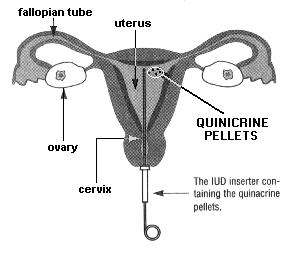
|
Fanatical veterans of the NSSM 200 frenzy:
THE QUINACRINE CHEMICAL STERILIZATION TECHNIQUE In modern warfare, the contraceptive arsenal has largely replaced conventional weapons.
From a report by Alix M. Freedman, Staff Reporter |

|
Fanatical veterans of the NSSM 200 frenzy:
THE QUINACRINE CHEMICAL STERILIZATION TECHNIQUE In modern warfare, the contraceptive arsenal has largely replaced conventional weapons.
From a report by Alix M. Freedman, Staff Reporter |
Quinacrine Sterilization

Because no surgery is involved, quinacrine sterilizations are relatively
straightforward procedures, and nurses and midwives perform them
routinely.
The health worker simply places the quinacrine pellets in a woman's uterus with an IUD inserter. It takes about a half hour for the pellets -- usually there are seven -- to dissolve in the uterus. The quinacrine then spreads a short distance into the fallopian tubes, destroying a portion of the tubes' inner lining. If the sterilization is successful, the resulting scar tissue blocks the tubes, preventing pregnancy.
To maximize quinacrine's effectiveness, a woman should be given a second seven-pellet dose one month after the first, Dr. Kessel and Mr. Mumford recommend.
Though the procedure, which takes 2-3 minutes to perform, can be painful, no anesthesia is used. Most women spend less than an hour recuperating in the clinic before they are sent home.

| PRODUCT | COST |
| Quinacrine* | $0.0081 |
| Intrauterine device | 0.42 |
| Birth-control pills | 3.15 |
| Depo Provera injections | 3.72 |
| Condoms | 6.48 |
| Norplant implants | 6.80 |
Family Planning Costs
The table shows contraceptive products' annual cost per couple in the Third World, in U.S.
dollars. Figures are based on what the U.S. Agency for International Development (USAID) pays for the contraceptives it distributes to the developing world, excluding all service/delivery-related costs such as patient counseling.
* Assumes two doses of seven pellets; USAID doesn't distribute quinacrine.